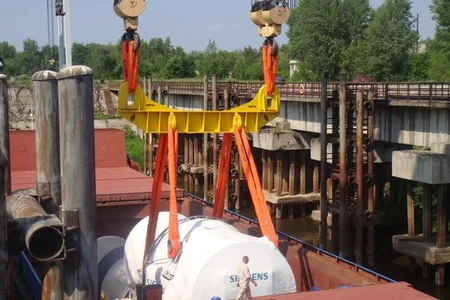Due to several variables, the choice between chain and synthetic slings impacts lifting efficiency. Dive into the details of our KnowHow to make an informed decision for your next lifting operation.
 Strength and Load Capacity
Strength and Load Capacity
- Chain Slings: These slings are renowned for their durability and high load-bearing capacity, making them suitable for handling heavy and abrasive loads. They excel in environments where strength and robustness are paramount, maintaining integrity under extreme pressures and challenging conditions.
- Synthetic Slings: Although lighter, synthetic slings offer impressive strength-to-weight ratios. They are suitable for various loads, providing flexibility without compromising load capacity. This flexibility makes them ideal for adaptable applications in diverse load shapes and sizes.

 Environmental Resilience
Environmental Resilience
- Chain Slings: Resilient to harsh environmental conditions such as heat and abrasion, chain slings thrive in demanding industrial settings and extreme weather conditions. They maintain their strength and integrity even in harsh environments.
- Synthetic Slings: They are well-suited for outdoor and marine applications as they resist UV rays, chemicals and moisture. They maintain their structural integrity in diverse environments, making them versatile in varying weather and chemical exposure. There are different material types for synthetic slings, each with chemical and environmental resistance properties. It is vital to select the correct material type for the operating environment that they will be subject to.
 Cost and Maintenance
Cost and Maintenance
- Chain Slings: Although they come with a higher initial cost, they offer longevity and require minimal maintenance. They boast a long operational life with proper care and regular inspections, potentially reducing the frequency of replacements.
- Synthetic Slings: Often more cost-effective in initial purchase and requiring less maintenance, synthetic slings might have a shorter lifespan than chain slings. This shorter lifespan may necessitate more frequent replacements, impacting long-term costs.

 Flexibility and Adaptability
Flexibility and Adaptability
- Chain Slings: Characterised by stiffness and minimal flexibility, chain slings maintain their shape under heavy loads. Their rigid structure makes them suitable for precise rigging applications where load stability is crucial. However, this rigidity might not be ideal for loads that require a more adaptable and cushioned approach.
- Synthetic Slings: Synthetic slings are renowned for their flexibility and adaptability, enabling them to conform easily to different load shapes and sizes. Their pliable nature and soft texture protect delicate surfaces and reduce potential damage, making them the preferred choice for loads prone to surface damage.
 Safety Considerations
Safety Considerations
- Chain Slings: Known for their visibility and durability, they exhibit visible signs of wear and tear, allowing for easier identification of potential failures. Regular inspections are crucial to identify issues early.
- Synthetic Slings: While they display visible signs of wear, aiding in identifying damage, synthetic slings may require more frequent inspections due to potential hidden damage that could impact their integrity. Australian standards AS 4997:2018 (Synthetic round slings) and AS1353.1 (Webslings) state that periodic inspections shall be performed no less than every three months by a competent person.
 Suitability for Specific Applications
Suitability for Specific Applications
- Chain Slings: Ideal for heavy, abrasive loads or applications demanding high resistance to wear and tear, ensuring durability and strength in demanding environments.
- Synthetic Slings: Suitable for delicate loads or surfaces prone to damage, offering protection and cushioning. They excel in scenarios where avoiding surface damage is critical.
Selecting between chain and synthetic slings involves considering load requirements, environmental conditions, and operational demands. Understanding the strengths and limitations of each sling type empowers businesses to make informed decisions tailored to their specific lifting requirements and operating environments.
Synthetic Sling Maintenance
A KnowHow to ensure the safety and longevity of your equipment.
Synthetic Sling Colour Coding
What do the colours mean? Which colour is right for me?



